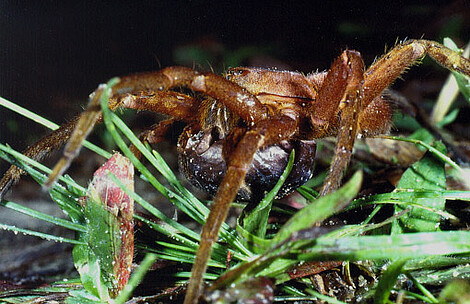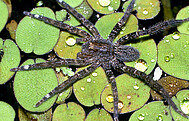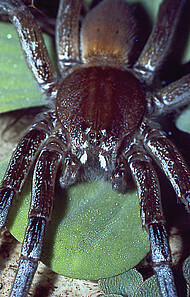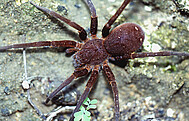Ancylometes – natural history
Notwithstanding its fascinating biology the (published) knowledge of most of the species' natural history and ecology is still sparse. We report here on our experiences, made over many years of field work in Amazonian dryland and inundation forests. Together with Thierry Gasnier, an arachnologist living in Manaus and the spider taxonomist Antonio Brescovit, we observed and captured these large spiders during many nightly excursions. During the day spiders hide in natural crevices. In strong contrast to Phoneutria specimens, which are equally abundant in these rainforests, Ancylometes spiders are strongly restricted to the forest floor, show no aggressive defensive behaviour and never tried to bite, when we captured them by hand.
A. rufus is the largest species, with beautifully white-banded, long-legged males (see Gallery). We have observed this species in terra firme (dryland) forests near Manaus (Reserva Ducke), most often near ponds or stream banks, but sometimes also far from visible water. I (H. Höfer) have seen one male feeding on a large frog and one female on a fish. The species is also known to hunt on tadpoles in this forest. A. rufus and bogotensis are frequently observed preying on fish (look in the Gallery for a nice observation in Trinidad).
A second, smaller species occurring in the same forests as A. rufus is A. terrenus. During a long time we have not recognized this species as belonging to the same genus. On the other hand the largest Ctenus species C. villasboasi has often been mistaken as Ancylometes.
A. hewitsoni is very abundant in floating meadows of the white water river Rio Solimões, and also in inundation forests. They hunt on tadpoles, frogs and grasshoppers, which are all abundant within the floating grass. Ancylometes spiders move easily and quickly on the water surface and also dive along structures to avoid predation. I (H. Höfer) once observed a specimen remaining more than 30 minutes under water.
Ancylometes females carry their large spherical brown egg-sac in the chelicerae (foto below), whereas Phoneutria fix their flat silk-white egg-sac on the substrate and guard it (see Gallery). Soon before the spiderlings hatch, Ancylometes females build a nursery web, fix the egg-sac in it and leave the place. Spiderlings hatch and stay for the first moults in the web, which seems to protect them.





